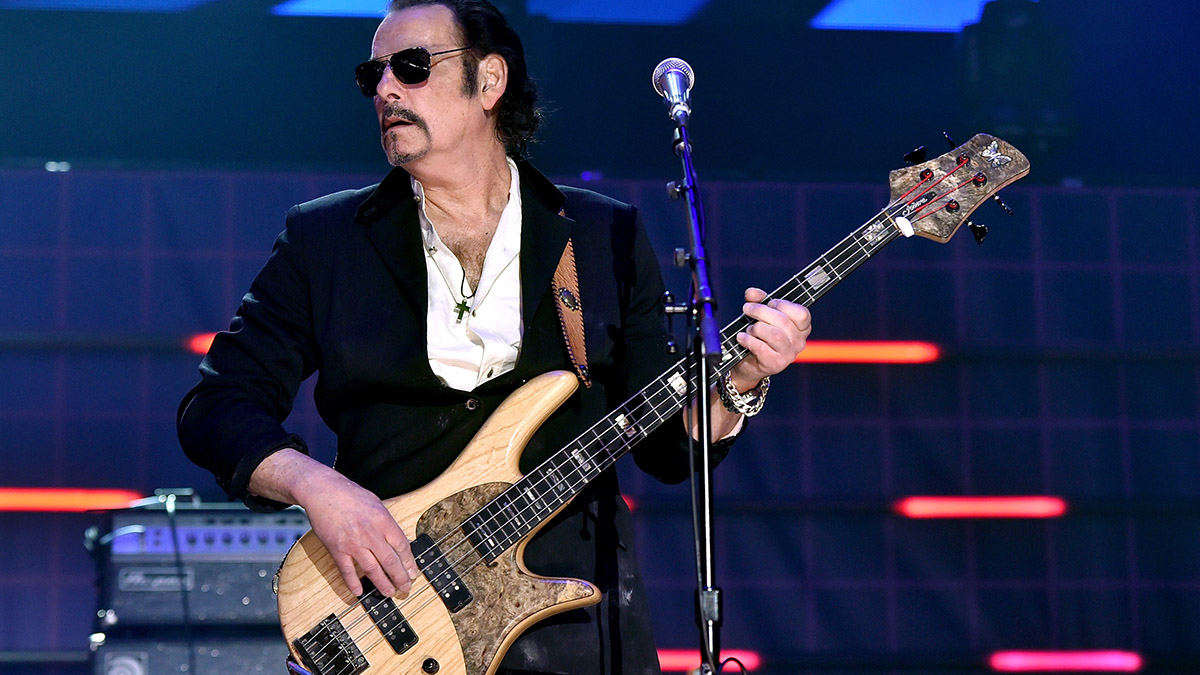The Knack’s Prescott Niles looks back on 5 of his best albums
A self-confessed bass addict, Prescott offers us the low-end perspective on the basslines behind of the catchiest hits in rock and new wave – and the catchiest bar none

The Knack’s huge 1979 hit My Sharona is instantly recognizable for its bouncing, new wave bassline. That iconic part was played by Prescott Niles, a musician keen to explore the different timbres of various bass guitars.
As well as being in the quintessential new wave act, Niles has worked with many alternative, pop, and classic rock bands. In fact, the New Yorker was hand-picked by none other than George Harrison to appear on the Shanghai Surprise movie soundtrack in 1986.
“At the time I lived in England,” says Niles. “The first thing George said to me was, ‘I heard My Sharona,’ so I felt I was respected and that I could play. Then I had the added pressure of playing with Jim Keltner on drums! A genius. I was reading from a chord chart. George had all these diminished ninths and all that stuff, and I was sweating. George was next to me. I passed the test because they didn’t stop the tape!”
The seal of approval from the humble megastar Harrison was a huge boost for Niles, whose three kids are also all musicians. Bass Player recently spent a very enjoyable hour or so chatting with the Knack man, who enlightened us on everything from Hendrix to palm muting on five albums significant to his career.
1. Velvert Turner Group – Velvert Turner Group (1972)
“I’m from Brooklyn; Velvert auditioned as a singer for a blues group I was playing in there, which was the first time I met him. I told him that he kind of looked a little similar to Jimi Hendrix, maybe a taller version. Velvert said, ‘Oh, I know him.’ Sure you do! A year later I was with him at Jimi Hendrix’s 25th birthday party!
“I got into a lot of shows as a result of knowing Velvert, including a place in Upper Manhattan where everybody jammed together; I learned a lot about improvising and not necessarily just playing what’s on the record. We were offered a record deal by Michael Lang, who had promoted Woodstock: that was amazing to me, as I’d been at the festival. So off we went to Los Angeles and started recording. I’m using a P-Bass on 90 percent of this album.
“I got it at a pawn shop. It was $95.99 and so I had to borrow money from my mom, although she wasn’t aware of it at the time. It was beat-up, and the paint was taken off, but you know, it’s become my holy grail. Everybody I’ve worked with loves the sound of it. It has great resonance, and I’ve never changed the pickups or had a fret job. It is just fantastic.”
Get The Pick Newsletter
All the latest guitar news, interviews, lessons, reviews, deals and more, direct to your inbox!
2. The Knack – Get The Knack (1979)
“By this point, I’d added a Gibson Thunderbird with a single pickup and a Rickenbacker to my collection, then I subbed for a bassist to a gig in LA. The club owner said, ‘Hey, you’re a good bass player, I got this bass here – and if you want it, it’s $100.’ It was a Guild M-85, and that’s what I used on My Sharona. There’s a Hofner on That’s What The Little Girls Do, and for Oh Tara that’s the Rickenbacker.
I was one of the first bass players to take off the pickup covers, like Les Paul guitarists sometimes do, and that was because the Guild didn’t have a lot of high-end
“I was one of the first bass players to take off the pickup covers, like Les Paul guitarists sometimes do, and that was because the Guild didn’t have a lot of high end. I thought it’d give me more presence, and I don’t know if that’s true or not, but it looked cool. I was using Dean Markley halfround strings – half roto and half regular – as Rotosounds are a little too bright sometimes.
“The Rickenbacker was mellower as it had flats, and didn’t have the punch of the Guild or the bottom end of the P-Bass. I’d also started using a Marshall head and a 4x12 cabinet. The Knack songs are real fast, so I was playing a lot of eighth notes. I liked switching between using a pick and using my fingers – I realized that I had to palm-mute lightly, not to deaden it too much. I also like chords: using fifths sounds great on bass.”
3. The Knack – Round Trip (1981)
“This album was produced by Jack Douglas of Cheap Trick. Mike Chapman had produced our first two albums, but he wasn’t on his game: I think he was going through some personal issues. Capitol also didn’t want us to release a new album, for some reason.
I’m playing a very McCartney bassline on Sweet Dreams. To this day, I marvel at some of his lines
“The band actually split up after the second album [...But The Little Girls Understand]. Then John Lennon was assassinated and I called Doug Fiegler [lead guitar, vocals] and said, ‘Whatever our problems are, can we do something?’ So we got in the studio with Jack, who is very meticulous about the sound.
“Round Trip has very diverse musical styles: for example, Africa was a funk song. On the first track, Radiating Love, you can really hear the Precision when I slide up to the higher notes. That’s the amazing thing about that P-Bass – it can also have a growl to it. I also used the Thunderbird on Boys Go Crazy, and a Vox Teardrop bass which I used on some overdubs.
“I’m playing a very McCartney bassline on Sweet Dreams. To this day, I marvel at some of his lines – I go, ‘Wow, what a brilliant idea’. The album is full of diversity, and that came from our collective abilities. I have to say that Jack also got my best bass sound ever.”
4. Josie Cotton – From The Hip (1984)
“I heard Josie playing in LA. She was cool, I liked her music, and I was lucky enough to get involved. We did a lot of TV, which we hadn’t done with The Knack – one of our cardinal sins. I was playing with a great drummer, Dony Wynn, who had worked with Robert Palmer. I realized how great he was – playing mainly eighth notes between the kick and snare.
On Life After Love I mostly did my own thing – and to my great joy, that became the main hook of the song
“I loved Robert Palmer: he was a great and under-appreciated singer. I’d bought a G&L double-pickup bass and I used that on a few songs, including Life After Love which has those Macca-like walking lines. The bass-line is featured throughout the whole song, which is a ’60s rock-style ballad. Working with Dony, there was a real pocket to it.
“The keyboards were more prominent, and I played a lot of eighth notes, which is my forte. I pretty much followed the guitar lines, but on Life After Love I mostly did my own thing – and to my great joy, that became the main hook of the song.
“It sounds really great on an antiquated jukebox: that ’50s sound is what you want. The bass has a hell of a punch to it, but also real warmth on the low-end. I can switch between fingers and pick in one bar, and I can really hear the difference.”
5. The Knack – Zoom (1998)
“I’m used a few different basses on this album. I had a Warwick, which I used on Mister Magazine, a song that had another McCartney kind of line. The opening’s got this high hook, a suspended fourth or sixth, going back to the low E. I was given some basses by VJ, who were just coming into prominence.
“Terry Bozzio was our drummer by then, and I can tell you that once you play with Frank Zappa, you can play anything. It was great recording with him; we worked really fast. I’d met Philip Kubicki, and he gave me this prototype bass which I used. A lot of people haven’t even heard of him, but his basses are fantastic.
“A funny story: I was playing my Kubicki in a bar once and someone came up to me and said, ‘Dude, what happened to that bass? It’s all messed up.’ I said, ‘I left it in the sun and the damn fretboard has gone weird.’ He went, ‘How do you play in tune?’ I said, ‘I don’t know – I gotta figure it out.’ Haha!
“If I want to play lower registers, that bass is incredible and sounds completely different to any of my other ones. I use it still. I have plenty of options for bass these days. I’ve even got an eight-string Rickenbacker now. I love playing bass – it’s a joy and a pleasure.”
Bass Player is the world’s most comprehensive, trusted and insightful bass publication for passionate bassists and active musicians of all ages. Whatever your ability, BP has the interviews, reviews and lessons that will make you a better bass player. We go behind the scenes with bass manufacturers, ask a stellar crew of bass players for their advice, and bring you insights into pretty much every style of bass playing that exists, from reggae to jazz to metal and beyond. The gear we review ranges from the affordable to the upmarket and we maximise the opportunity to evolve our playing with the best teachers on the planet.











